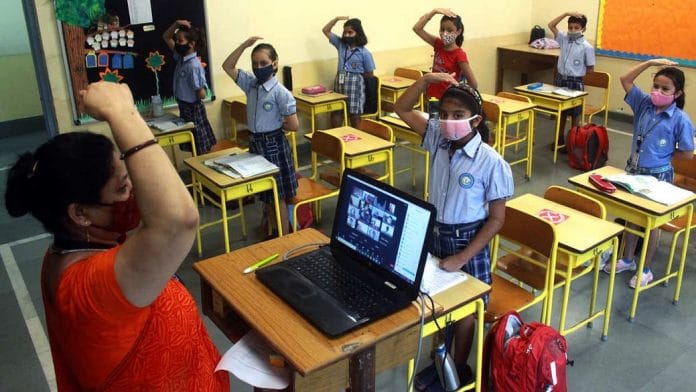Imagine connecting every school in the world to the internet. It is possible. It is also necessary if we want to keep the digital divide from becoming a digital chasm.
Now think about schools and the role they play in anchoring your community as well as the role they have played in your life. Across the globe, they are places where children and adults come together to learn. Schools are also where entire communities gather for celebrations, in times of crisis, to vote or to access health and emergency services.
During the COVID-19 pandemic, 1.6 billion children globally were affected by school closures. Nearly 77 million children and young people have been shut out of their classrooms for the past 18 months. Around a quarter of countries continue to have schools fully or partially closed.
Yet we have found opportunities during this time of hardship. We have seen what can be achieved when students, parents and teachers use digital connectivity to teach and learn wherever and whenever possible. Unfortunately, many of the students who could not access the digital tools needed to sustain their learning are now at risk of being left further behind – even without COVID-19 compounding the divide
Prior to the pandemic, a lack of access to the internet did not necessarily prevent children from receiving an education, but, since COVID-19 upended education systems across the globe, the link between school and personal connectivity to quality education is clearer than ever. This is highlighted in Connecting Learners: Narrowing the Educational Divide, an Economist Intelligence Unit (EIU) report sponsored by Ericsson in support of UNICEF.
Connecting schools is good for the economy
The EIU report suggests that a 10% increase in schools’ connectivity in a country can increase the effective number of schooling years per student on average (a measure of education quality not just quantity) and also results in a GDP per capita increase of 1.1%. The EIU economic model also suggests that the least connected countries in the world – like Niger – could realize up to a 20% increase in GDP if school connectivity increases to the levels of a developed country, like Finland.
The authors also concluded that to take full advantage of connectivity, teachers and students must have proper support and tools, including devices, learning resources and help with integrating technology into educational settings. This is true in low, middle and high-income countries, and in both urban and rural areas. The quality and affordability of connectivity are also critical issues that must be addressed.
The benefits of school connectivity do not stop at the individual student. Spillover effects from connected schools benefit whole communities. They serve as community focal points for lifelong learning and development, as well as enhancing the quality of digital literacy among the populations in developing world economies. This directly benefits economic growth by stimulating entrepreneurship and commerce.
Connecting every school to the internet by 2030
So how do we accomplish this? It’s a huge task as no one knows for sure how many schools there are in the world or exactly where they’re located.
In 2019, UNICEF and the International Telecommunication Union (ITU) launched Giga, an initiative to connect every school in the world to the internet. Working initially with 19 countries (and growing), Giga maps school connectivity in real-time, creates models for innovative financing and supports government contracting for school connectivity. It is now preparing to launch a $5 billion connectivity bond to finance last-mile infrastructure and stimulate investment.
Based on a belief that connectivity can improve lives and help pioneer a sustainable future, Ericsson has partnered with UNICEF to help tackle the challenge of mapping schools and assessing their connectivity in 35 countries by the end of 2023. Together with national governments and other partners, Giga has now mapped 1 million schools and their connectivity levels. These insights will make it possible to aggregate demand and target critical investments in new infrastructure.
For its part, Ericsson is building on its communication infrastructure capabilities coupled with data science and artificial intelligence expertise to collect, validate, analyse, monitor and visualize real-time connectivity data.
We need more than connectivity
Collaboration is crucial: both government and the private sector need to create holistic strategies to overcome the barriers to school connectivity. Digital inclusion is also about more than just access. Connectivity that is not only accessible but also affordable could be a game-changer for learning, particularly in remote areas and areas with lower availability of teachers.
This digital infrastructure – combined with support to teachers and students – can also enable new types of learning opportunities that complement and enrich in-person learning. Hybrid, blended and online options can help democratize access and make high-quality education much more accessible for all. They will also give students greater flexibility over when, where and how to engage with learning, as well as potentially providing valuable information to teachers and parents to better target face-to-face support.
Imagine putting the accumulated knowledge of the world at the fingertips of all children and adults in their own language. It’s possible. We saw what kind of major digital leap was possible in 2020. We need to be ready for changes of that magnitude. We cannot continue to leave billions of our fellow people behind.
Börje Ekholm, President and Chief Executive Officer, Ericsson
Henrietta H. Fore, Executive Director, United Nations Children’s Fund (UNICEF)
This article was originally published on the World Economic Forum (WEF).
Also read: As work-from-home era ends, over 90% Indians want colleagues vaccinated, WEF survey finds






